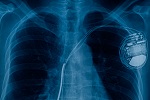Heart Powered Pacemakers

We don't give a thought to replacing batteries, like the ones in my watch. But for millions of people with pacemakers near their hearts, changing that battery requires surgery! Maybe one day they won't need to because some clever scientists invented a pacemaker that's powered by the heart itself.
That's pretty ingenious. Three million people worldwide now live with lifesaving pacemakers and another six hundred thousand get one implanted yearly. Pacemakers correct bradycardia which is heartrate lower than sixty beats.
When the heart doesn't contract sufficiently, the organs don't get the oxygen they need. The heart has a built in pacemaker called the sinoatrial node or SA node. It's a special cluster of cells that generates electrical impulses in the heart. When the SA node isn't working right, pacemakers can correct the problem.
They're small, battery operated computers implanted beneath the skin in the chest that sense and track heart rhythm. Wires connected to that computer have their other end implanted into the heart and can transmit electrical impulses to restore a normal rhythm. When the battery runs low, the pacemaker is usually replaced with surgery.
To avoid this hassle, developers of the new pacemaker are harnessing the heart's kinetic energy. Instead of the standard lead wires, the team has added a thin polymeric piezoelectric film over the wires. The film converts the kinetic energy of the heart's movement into electricity to charge the pacemaker battery. This wire would also collect data about heart function that's critical to patients' doctors.
The first round of testing is in pig hearts. Hopefully, successful studies will soon lead to human clinical trials.
More Information
Medical marvel: A new device will use heart's energy to power pacemakers
The heart's motion is so powerful that it can recharge devices that save our lives...
National Heart, Lung, and Blood Institute Pacemakers Health Topics Page
Medical Definition of SA node
The SA node (SA stands for sinoatrial) is one of the major elements in the cardiac conduction system, the system that controls the heart rate. This stunningly designed system generates electrical impulses and conducts them throughout the muscle of the heart, stimulating the heart to contract and pump blood...
Where in the heart is the sinoatrial node located?
The sinoatrial node is located in the superior wall of the right atrium...